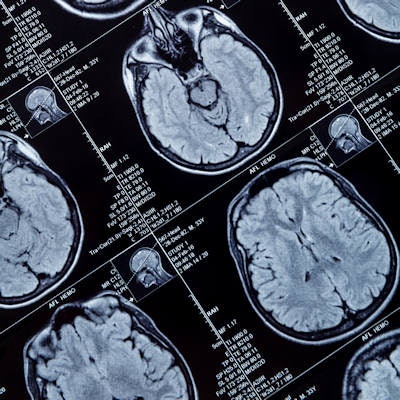
Using 7-tesla MRI scans, researchers have identified a potentially valuable biomarker of brain inflammation in patients with multiple sclerosis (MS) that could shed light on how the disease progresses, according to a study published online November 12 in the Multiple Sclerosis Journal.
A team of researchers from Brigham and Women's Hospital used ultrahigh-field MRI scanning to examine leptomeningeal enhancement and its association with cortical and thalamic lesions in the brain's gray matter, which are indicative of brain damage in patients with MS.
"The 7-tesla MRI scanner affords us new ways of viewing areas of damage in neurologic diseases such as MS that were not well seen using 3-tesla MRI; it's capturing nuances that we would otherwise miss," lead author Dr. Jonathan Zurawski, a neurologist at Brigham and Women's Hospital in Boston, said in a statement. "The 7-tesla scanner reveals markers or signatures that were poorly characterized or overlooked and may allow us to better understand the disease process and ultimately better treat MS patients."
It is believed that a better understanding of MS progression can be achieved by studying immune system activity along the surface of the brain, which is covered by the meninges. Inflammation of the meninges is one of the characteristics of relapsing-remitting MS, and one way to identify the condition is by leptomeningeal enhancement through MRI.
Previous MS studies with 3-tesla MRI have shown that leptomeningeal enhancement occurs in 20% to 50% of patients with progressive MS. Now, with the advent of 7-tesla MRI, researchers have discovered leptomeningeal enhancement in approximately 90% of MS patients. The condition is particularly onerous because it can persist for years and cause an MS patient's disability to progress even further.
To explore the influence of leptomeningeal enhancement in the disease, Zurawski and colleagues enrolled 30 patients (mean age, 44.0 ± 11.3 years) with relapsing-remitting MS and 15 heathy control subjects (mean age, 44.1 ± 10.0 years), all of whom underwent 7-tesla MRI scans (Magnetom Terra, Siemens Healthineers) with a 32-channel receive head coil to detect leptomeningeal enhancement and gray-matter lesions.
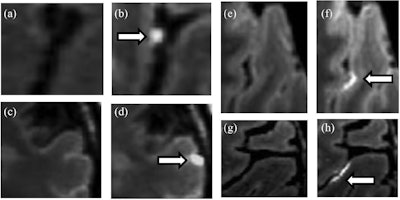 Images show examples of leptomeningeal enhancement in relapsing-remitting MS subjects as detected by 3D fluid-attenuated inversion-recovery (FLAIR) sagittal sequences at 7-tesla MRI. Pre- (a, c, e, g) and postcontrast (b, d, f, h) images showing representative foci of leptomeningeal enhancement arrows. Characteristic nodular leptomeningeal enhancement foci (b, d; arrows) found within a sulcus (b) and at the pial surface (d). Spread/fill leptomeningeal enhancement focus examples (f, h), with contrast layering within the sulcal depth (arrows). Images courtesy of Brigham and Women’s Hospital and the Multiple Sclerosis Journal.
Images show examples of leptomeningeal enhancement in relapsing-remitting MS subjects as detected by 3D fluid-attenuated inversion-recovery (FLAIR) sagittal sequences at 7-tesla MRI. Pre- (a, c, e, g) and postcontrast (b, d, f, h) images showing representative foci of leptomeningeal enhancement arrows. Characteristic nodular leptomeningeal enhancement foci (b, d; arrows) found within a sulcus (b) and at the pial surface (d). Spread/fill leptomeningeal enhancement focus examples (f, h), with contrast layering within the sulcal depth (arrows). Images courtesy of Brigham and Women’s Hospital and the Multiple Sclerosis Journal.As one might expect, 7-tesla MR images revealed leptomeningeal enhancement in 20 MS patients (67%), compared with only one leptomeningeal enhancement (7%) among the healthy controls. The researchers also observed a total of 54 foci of leptomeningeal enhancement among those 20 subjects for a mean of 2.7 (± 1.5; range 1-6) foci per patient.
In a further comparison of MS patients with or without leptomeningeal enhancement, subjects with the conditions had significantly more cortical and thalamic lesions in their gray matter and longer disease duration than MS patients with no such condition.
| 7T MRI of MS patients with and without leptomeningeal enhancement | |||
| LME+ MS patents | LME- MS patients | p-value* | |
| Disease duration | 14.9 ± 10.4 years | 8.1 ± 5.7 years | 0.028 |
| Cortical lesions | 21.5 ± 12.6 | 5.5 ± 5.0 | < 0.001 |
| Thalamic lesions | 3.95 ± 2.11 | 0.70 ± 1.34 | < 0.001 |
LME-: MS patients without leptomeningeal enhancement.
*All p-values are statistically significant.
"Gray-matter injury is an important part of MS, which may be a key factor leading to disease progression," Zurawski added. "Our hope is that by finding new markers of this progression, it opens up the opportunity for developing treatments that can prevent progression before lesions become widespread."
The Brigham and Women's researchers are following the patients in this study over the coming months and years to see how their degree of leptomeningeal enhancement might change, and they plan to add more subjects to their cohort in the future.


.fFmgij6Hin.png?auto=compress%2Cformat&fit=crop&h=100&q=70&w=100)
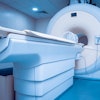

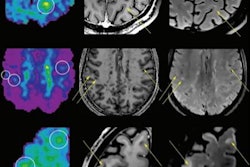
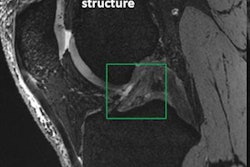
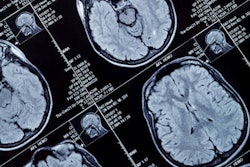
.fFmgij6Hin.png?auto=compress%2Cformat&fit=crop&h=167&q=70&w=250)











